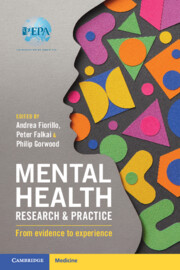Book contents
- Mental Health Research and Practice
- Mental Health Research and Practice
- Copyright page
- Contents
- Contributors
- Preface
- Chapter 1 Chemical and Behavioral Addictions
- Chapter 2 Nonsuicidal Self-Injury in Adolescents
- Chapter 3 Consultation-Liaison Psychiatry and Psychosomatics
- Chapter 4 Recent Developments in Cultural Psychiatry
- Chapter 5 New Perspectives in Eating Disorders
- Chapter 6 Emergency Psychiatry
- Chapter 7 How Can Forensic Psychiatry Contribute to Legal and Ethical Controversies in Society?
- Chapter 8 Diagnosis of Co-occurrent Mental Health Problems in Persons with Intellectual Disability, Major Communication and Insight Difficulties, and Stressor-Related Disorders
- Chapter 9 Attention Deficit Hyperactivity Disorder in Adults
- Chapter 10 Translational Neuroimaging in Psychiatry
- Chapter 11 Challenges in the Therapy of Psychiatric Disorders in the Elderly
- Chapter 12 Position-Taking
- Chapter 13 Physical Health of Patients with Schizophrenia
- Chapter 14 Evolving Concepts for the Assessment and Treatment of Schizophrenia
- Chapter 15 The Role of Rapid-Acting Antidepressants in Suicidal Crisis Management
- Chapter 16 Telemental Health Care
- Chapter 17 Development and Current Status of ICD-11 Mental, Behavioral, or Neurodevelopmental Disorders
- Chapter 18 Anxiety Disorders
- Chapter 19 Did We Lose Interest and Pleasure in the Concept of Major Depression?
- Chapter 20 Personality Disorders
- Index
- References
Chapter 3 - Consultation-Liaison Psychiatry and Psychosomatics
From Subspecialty to Forma Mentis
Published online by Cambridge University Press: 01 February 2024
- Mental Health Research and Practice
- Mental Health Research and Practice
- Copyright page
- Contents
- Contributors
- Preface
- Chapter 1 Chemical and Behavioral Addictions
- Chapter 2 Nonsuicidal Self-Injury in Adolescents
- Chapter 3 Consultation-Liaison Psychiatry and Psychosomatics
- Chapter 4 Recent Developments in Cultural Psychiatry
- Chapter 5 New Perspectives in Eating Disorders
- Chapter 6 Emergency Psychiatry
- Chapter 7 How Can Forensic Psychiatry Contribute to Legal and Ethical Controversies in Society?
- Chapter 8 Diagnosis of Co-occurrent Mental Health Problems in Persons with Intellectual Disability, Major Communication and Insight Difficulties, and Stressor-Related Disorders
- Chapter 9 Attention Deficit Hyperactivity Disorder in Adults
- Chapter 10 Translational Neuroimaging in Psychiatry
- Chapter 11 Challenges in the Therapy of Psychiatric Disorders in the Elderly
- Chapter 12 Position-Taking
- Chapter 13 Physical Health of Patients with Schizophrenia
- Chapter 14 Evolving Concepts for the Assessment and Treatment of Schizophrenia
- Chapter 15 The Role of Rapid-Acting Antidepressants in Suicidal Crisis Management
- Chapter 16 Telemental Health Care
- Chapter 17 Development and Current Status of ICD-11 Mental, Behavioral, or Neurodevelopmental Disorders
- Chapter 18 Anxiety Disorders
- Chapter 19 Did We Lose Interest and Pleasure in the Concept of Major Depression?
- Chapter 20 Personality Disorders
- Index
- References
Summary
This chapter provides an overview concerning the historical development of consultation-liaison psychiatry (CLP) and details the meaning of consultation and liaison activity. The procedure of consultation is detailed. Several assessment tools that support clinical investigation are presented and discussed. Specifically, the assessment of personality traits, anxiety and depressive symptoms, and other psychological factors are addressed. As far as clinical research is considered, two topics are presented: CLP within the psycho-neuro-endocrine-immune perspective and CLP in the field of transplants. Finally, special attention is dedicated to the impact of CLP on health care budgets and to the role played by CLP in end-of-life care. Several skills are required in the field of CLP. Some are general (e.g., assessment of psychiatric diagnosis and medical-psychiatric comorbidity, use of psychopharmacological treatments, etc.); others are specific to the setting (e.g., transplantation, end-of-life-care, etc.). Once acquired, both general and specific skills may be implemented in psychiatric settings other than the CLP, thus representing professional assets potentially useful in all psychiatric settings. Therefore, CLP should be considered not only as a subspecialty of psychiatry, but also as a forma mentis, a professional attitude that the psychiatrist may implement in several psychiatric settings.
Keywords
- Type
- Chapter
- Information
- Mental Health Research and PracticeFrom Evidence to Experience, pp. 27 - 48Publisher: Cambridge University PressPrint publication year: 2024

